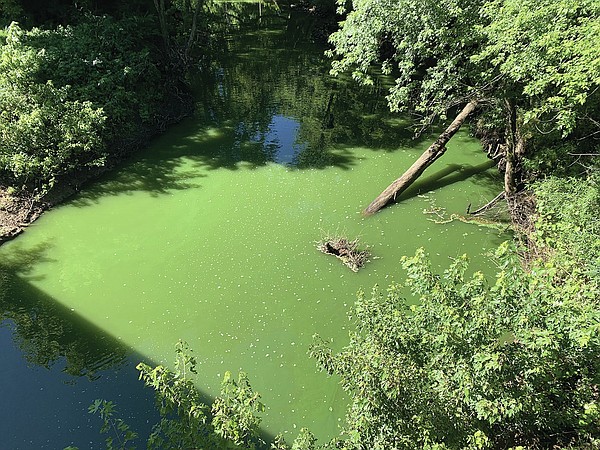[ad_1]
State officials issued the first nuisance algae bloom advisory of the year on June 25 after test results of samples of green and smelly growth spotted on the Poteau River exceeded safe recreational levels.
The Environmental Quality Division of the Arkansas Department of Energy and Environment has warned the public to avoid contact with the river in the affected area between US 71 and Arkansas 80 West, near the small town of Waldron in the west-central state.
During these blooms, people and pets are advised to avoid any aquatic activity that presents a risk of water ingestion or skin exposure, such as swimming, kayaking, fishing or even paddling. , advised Richard McMullen, associate director for science and Center for Local Public. State Health Environmental Health Director at the Arkansas Department of Health.
“Contact with contaminated water can make people sick, and even pets can be affected,†McMullen said. “Certain harmful algae, called cyanobacteria, can cause rashes and gastrointestinal illnessâ€, such as upset stomach, nausea, vomiting and / or diarrhea.
According to the Department of Health, the state has received reports of people becoming ill after being exposed to algae blooms in recent years, but no associated toxins have been officially linked to these illness reports.
Harmful algal blooms are a major environmental problem in all 50 states, according to the Federal Environmental Protection Agency.
The state’s Environmental Quality Division did not provide an interview after several requests last week and did not respond to questions regarding the number of public reports of algae blooms or algae blooms. official notices issued in recent years.
In 2019, toxins were too high on Catherine Lake for a short time and toxins in Brewer Lake, a drinking water supply, were too high in raw water for infants. According to ADEQ press releases, a notice was issued for Lake Hamilton on July 15 of last year and remained in effect until August 13.
These public advisory opinions are part of the Harmful Algae Overgrowth Management Plan released in 2020 by a task force of Arkansas water resources professionals across the state. Previously, Arkansas did not have a protocol in place to respond to cyanobacterial events – also known as blue-green algae.
The Poteau River was also subject to an advisory in early August 2020 around the same area as the June bloom. This is unusual because harmful algal blooms are more often seen on lakes, said Brian Haggard, director of the Arkansas Water Resources Center at the University of Arkansas, in Fayetteville.
Algae are important for the health of lakes and rivers because they form the basis of the aquatic food chain. Most harmful blooms occur in warm, slow-moving waters subject to plenty of sunlight, according to the EPA website.
“These blooms can kind of be localized but can also be generalized,†Haggard said. “One of the things we noticed is that they’re there one day and then the next week they’re gone. They can be very episodic, but they can also hang around for a long time.”
The last bloom had already visually dissipated Thursday near the Arkansas 80 Bridge crossing where it was first spotted by one of Haggard’s graduate students. The notice was not publicly lifted on Sunday.
Algae blooms in general can be an aesthetic and recreational nuisance and can consume too much oxygen from the water, killing fish. The harmful blooms may look more like spilled pea soup or blue-green paint on the surface of the water, according to the resource center, and the cells may form into small, round clumps or take on the appearance of grass clippings.
However, lab tests are the only way to confirm that the toxins are actually present, Haggard said. The Little Rock Resource Center and Environmental Quality Division have laboratories capable of testing samples.
The management plan recommends that a public notice be issued if an overgrowth of cyanobacteria is visually identified, regardless of the concentration of toxin. Once tested, he recommends closing a recreation area if the toxins are above EPA recommended values.
The center generally addresses concerns in northwest Arkansas and since 2019 has been closely monitoring Lake Fayetteville, which experiences frequent algal blooms with widely varying levels of toxins. Monitoring can help alert the public when toxins sometimes exceed recommended levels, but is also done for research purposes.
“With Lake Fayetteville, we are doing a lot of experiments on the water in this lake to see how nutrients, both nitrogen and phosphorus, could trigger the production of toxins by cyanobacteria,†Haggard said.
The center also analyzes water samples from private landowners for a basic processing fee of $ 5 plus an additional analysis fee. They receive one or two samples per month from people who fear a harmful algal bloom.
When it comes to an algae bloom, it’s better to be safe than sorry, said McMullen. Avoid contact.
“If you suspect that someone has become ill after coming into contact with contaminated water, they should see their doctor,” he said. “If your pet gets into the water, he should be washed immediately with tap water. Don’t let him lick himself to clean himself as he could get sick.”
Suspected harmful algal blooms can be reported by emailing [email protected] or calling (501) 682-0744.
[ad_2]

